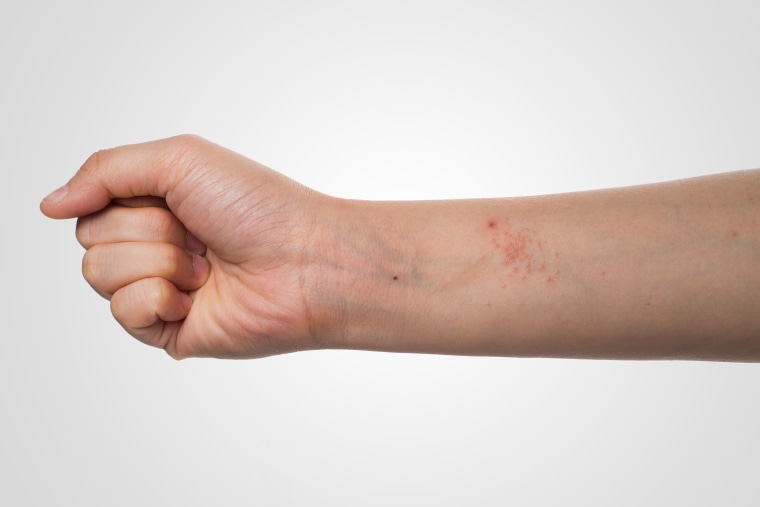Wanted: A few adults and a few more kids who don’t mind having some bacteria sprayed on their skin.
A team at the National Institutes of Health hopes they can cure, or at least ease, eczema by spraying “good” germs onto the skin of sufferers.
The idea is to restore the skin to its normal, healthy balance.

It’s one of the first tests of a treatment aimed at altering the skin’s microbiome — the collection of bacteria, fungi and other microorganisms that live on the skin.
The cost, they hope, will be around $100 or so.
That’s a big contrast to a new eczema drug that is making headlines this week. The Food and Drug Administration just approved Dupixent, a $37,000-a-year injectable drug to help ease the itching, swelling, redness and crusting caused by the most severe cases of eczema.
Related: The New Frontier in Medicine - the Microbiome
“Our hope is that by correcting bacteria on the skin, patients won’t have to do constant treatment,” said Dr. Ian Myles of the National Institute of Allergy and Infectious Diseases, one of the NIH institutes.
The study is one example of many research studies funded by the NIH, whose budget is in the crosshairs of the Trump administration. Some members of Congress have promised to fight President Donald Trump’s proposal to slash the NIH budget by $1.2 billion this year and by a full 20 percent next year.
“Our hope is that by correcting bacteria on the skin, patients won’t have to do constant treatment."
Most eczema drugs are creams or lotions designed to soothe the inflammation that makes eczema — formally known as atopic dermatitis — so uncomfortable. Dupixent is a monoclonal antibody that alters the immune system response that underlies inflammation.
Dr. Ian Myles and his colleagues are taking a completely different approach. They are building on research that shows people with atopic dermatitis have unhealthy bacteria on their skin.
“Those bacteria are deficient compared to the same bacteria taken from a healthy volunteer,” Myles, who is leading the study, told NBC News.
“We have done some genetic testing that tells us definitively that those bacteria are different.”
Related: White House Backs New Microbiome Project
While people with eczema appear to have mostly the same species of bacteria as people without, the types that Myles’s team tested seemed weaker. He believes that these weak bacteria aren’t doing their jobs and can’t compete with harmful bacteria, such as Staphylococcus aureus.

Myles and colleagues have been growing bacteria in the lab taken off healthy volunteers and people with atopic dermatitis. They’ve focused on one particular species: Roseomonas mucosa.
Tests on human skin cells in lab dishes and on mice show that healthy versions to R. mucosa can eradicate eczema and make skin cells healthier, Myles said.
“We took the bacteria from healthy people and we saw that the bacteria does everything you would want it to do to improve atopic dermatitis in a petri dish and in mice,” he said.
Related: Gut Germs May Affect Parkinson's
It improved the way skin cells use vitamin D, made the skin cells stronger and helped kill off staph bacteria.
“In mice, we can actually make their disease go away with this bacteria,” Myles said.
Myles and colleagues have purified the healthy Roseomonas bacteria and made it into a spray. They’ll try it first on healthy adults to make sure it’s safe, and then they want to recruit kids 7 and older with atopic dermatitis to try it out.
The phase 1 study is aimed at ensuring the treatment is safe, but Myles hopes to show it's effective, also. If it is, it would be years away from the market because it will have to go through phases of testing and then be licensed to a company to produce it.
They are not the only team trying to use good bacteria to help eczema. Richard Gallo of the University of California, San Diego, and colleagues have been trying a lotion using two benign staph bacteria — Staphylococcus hominis and Staphylococcus epidermidis — to fight the effects of the harmful Staphylococcus aureus.
Related: You Live in Your Own Germ Cloud
“Twenty-four hours later, it was clear—the probiotic lotion reduced levels of the bad bug, Staph aureus, on the participants’ skin,” NIH director Dr. Francis Collins wrote in his blog. The NIH is helping to pay for Gallo’s study.
“Hopefully, the promise of these new findings can provide some encouragement to the more than 31 million Americans, many of them children, who now suffer from eczema,” he added.
The microbiome includes the organisms that live in and on the body. They help digest food, affect appetite, influence disease and may even control mood.
The best known example of using the microbiome to treat disease is the development of poop pills to cure Clostridium difficile infections.
